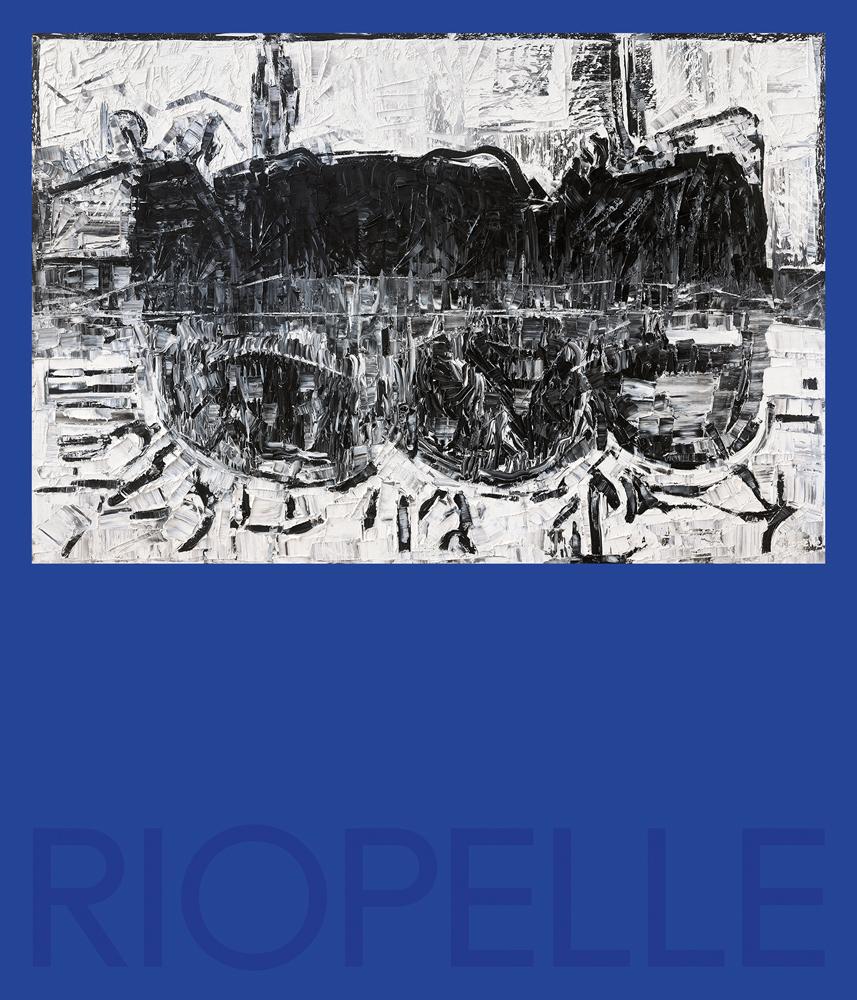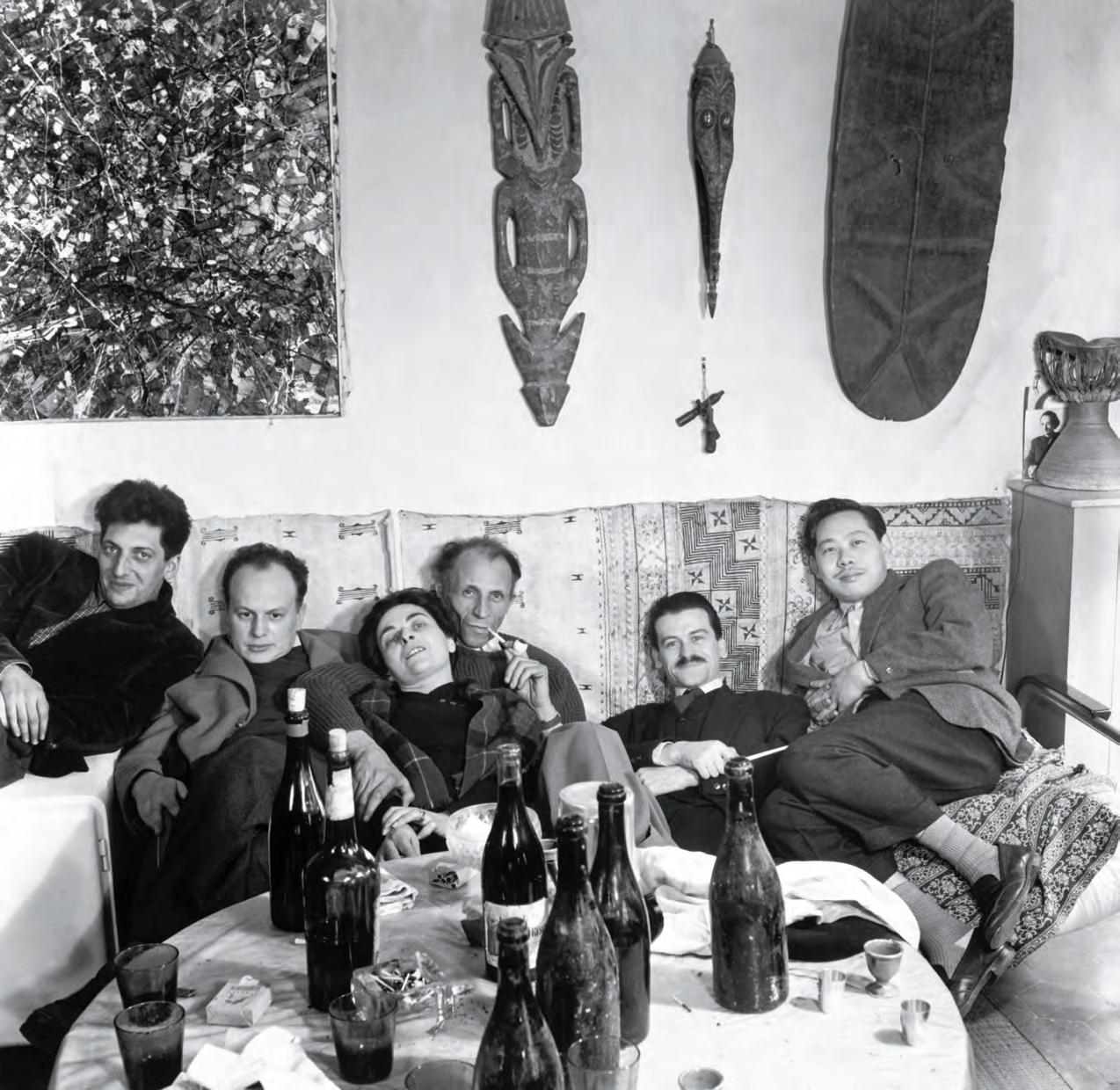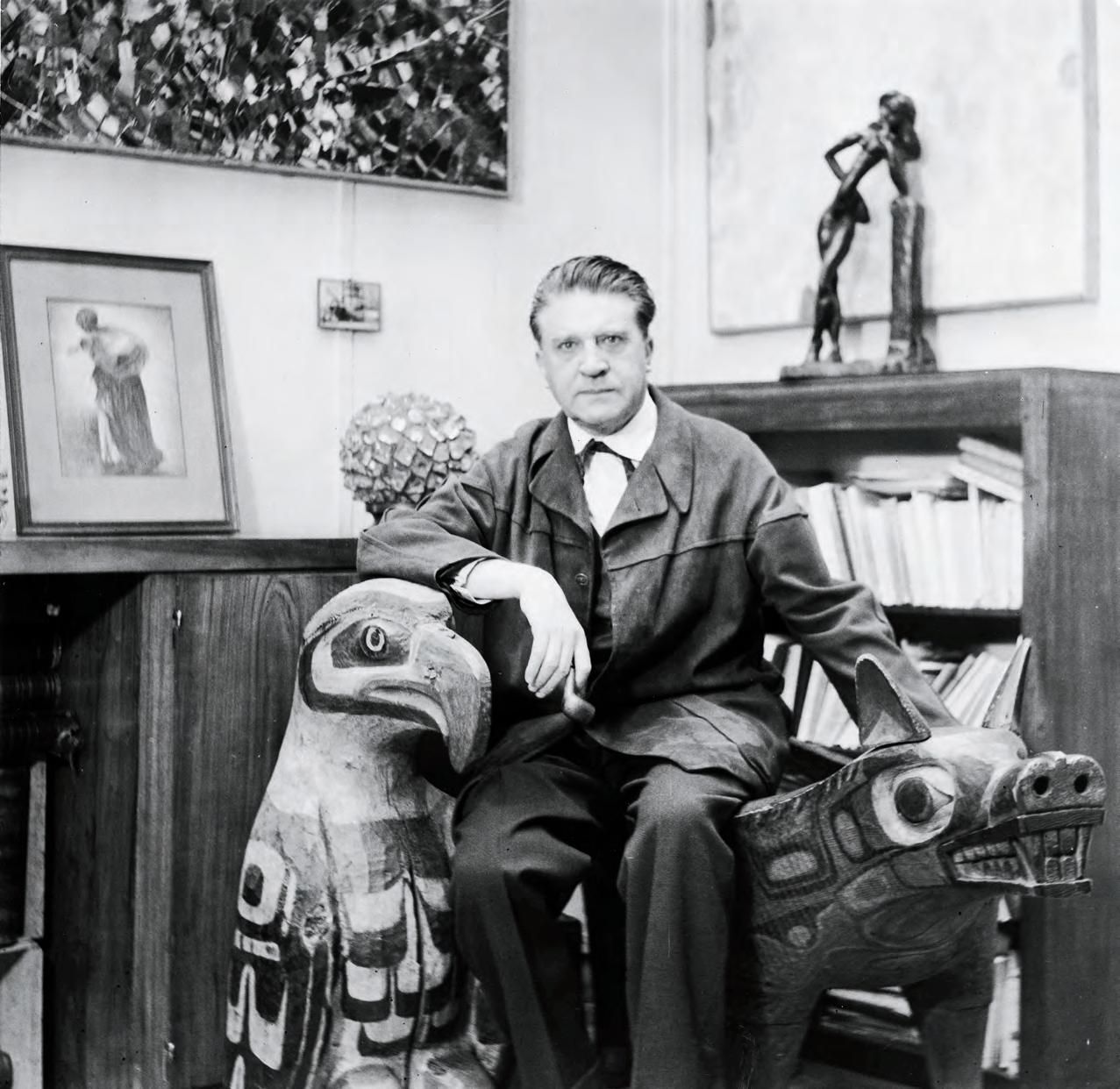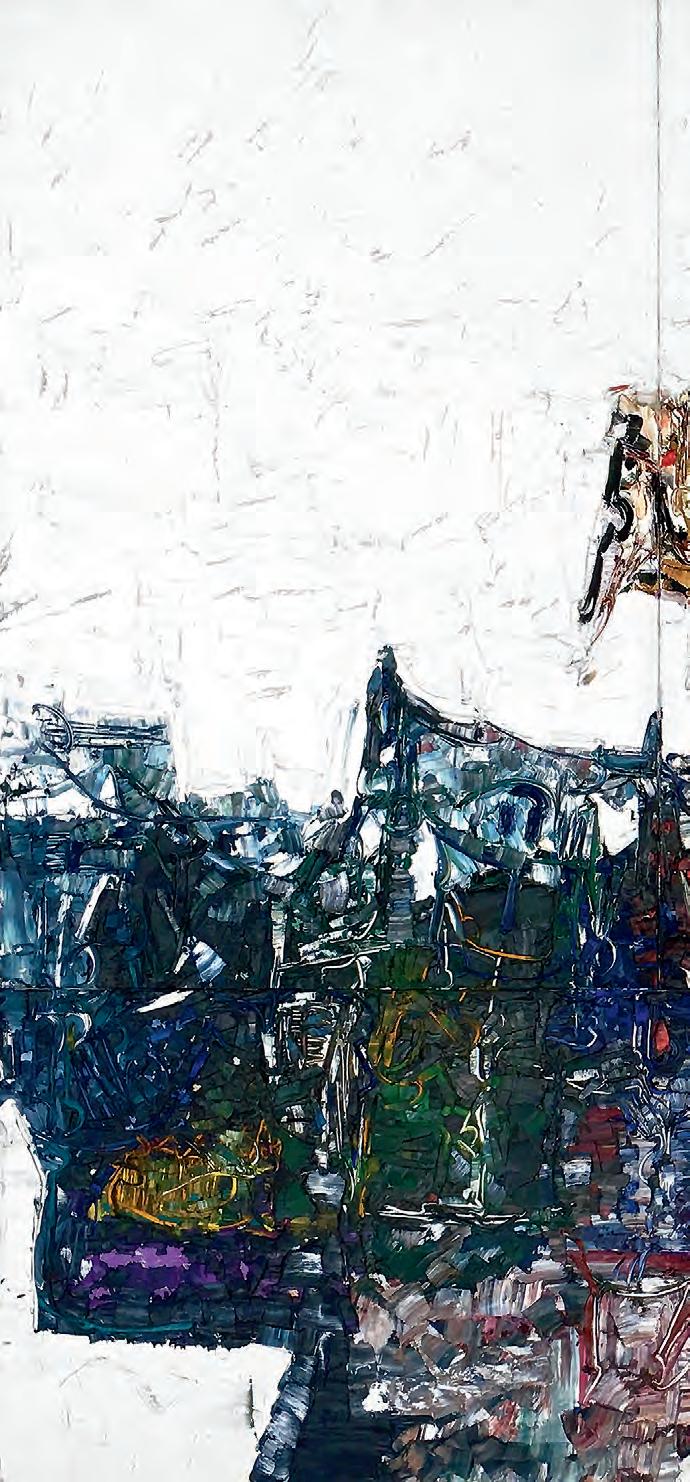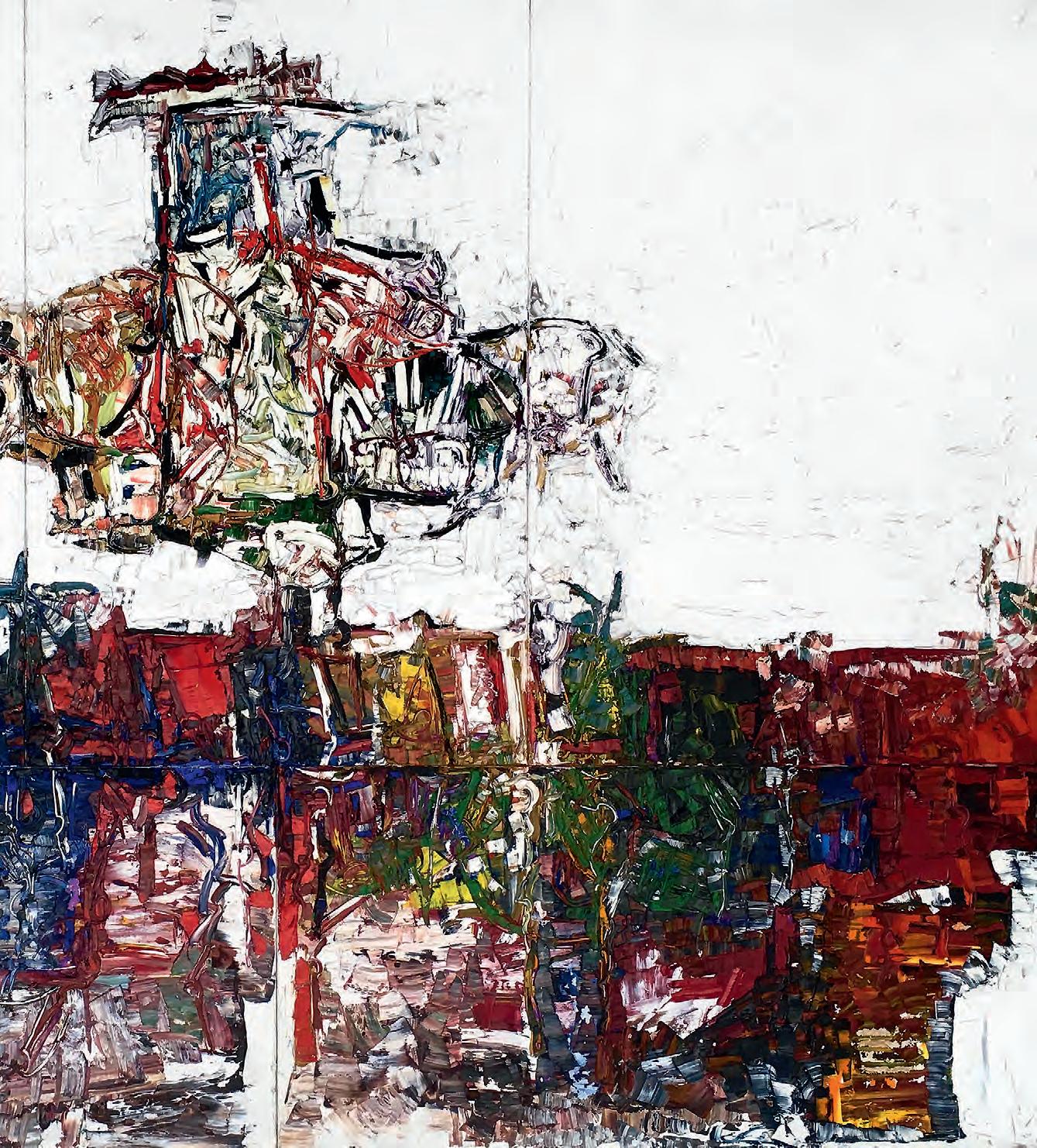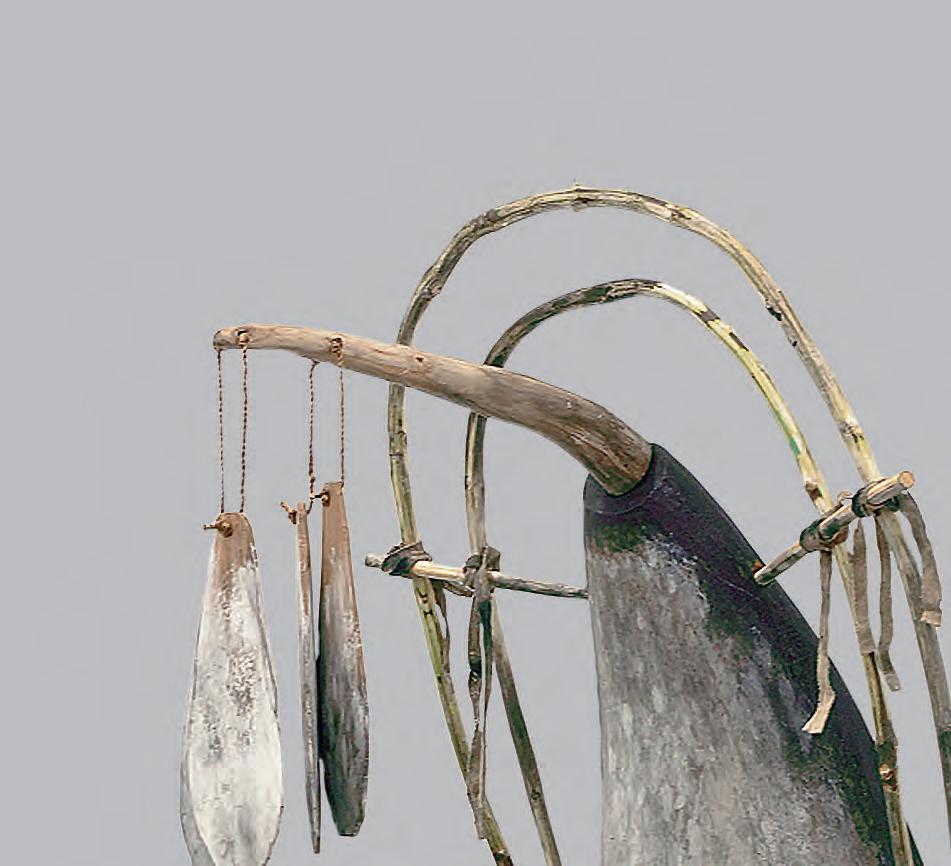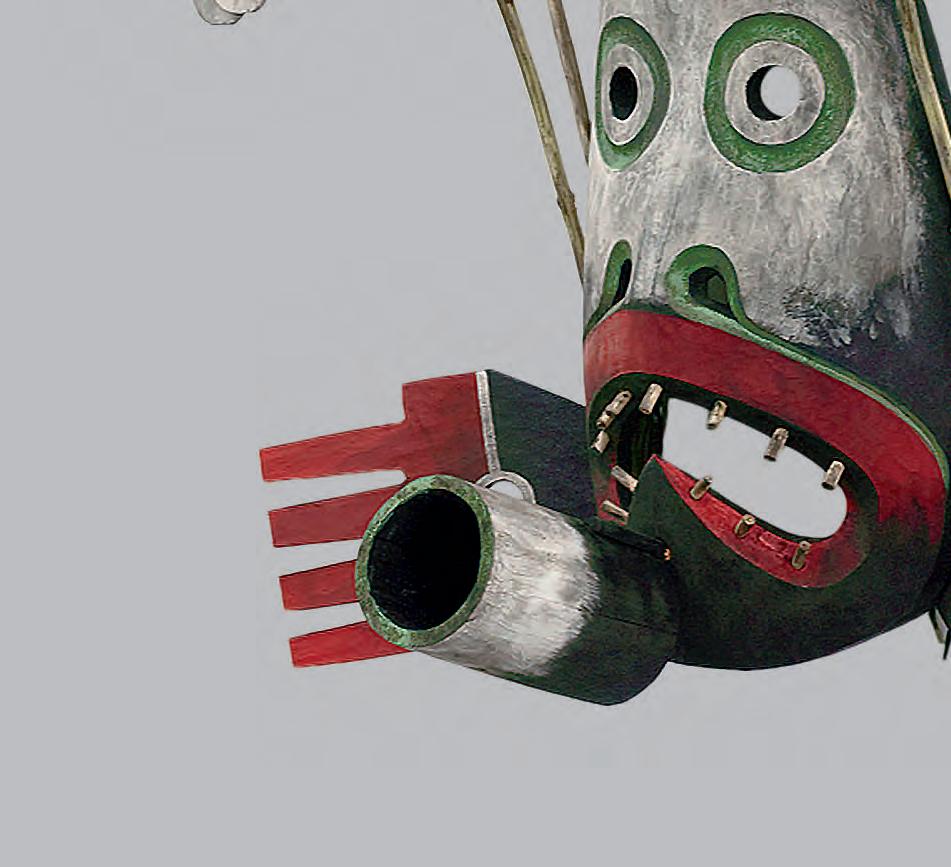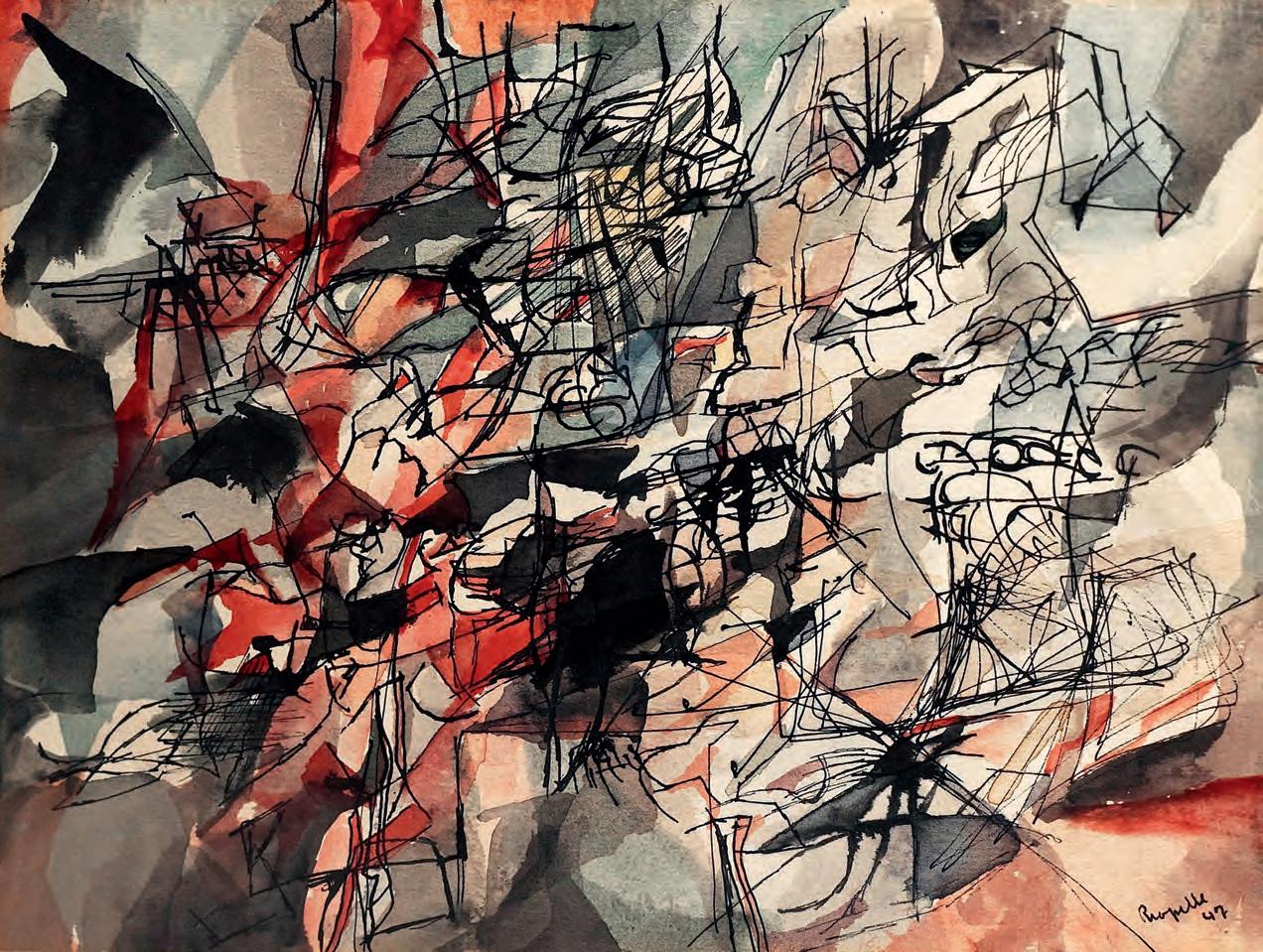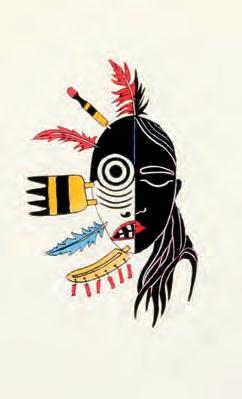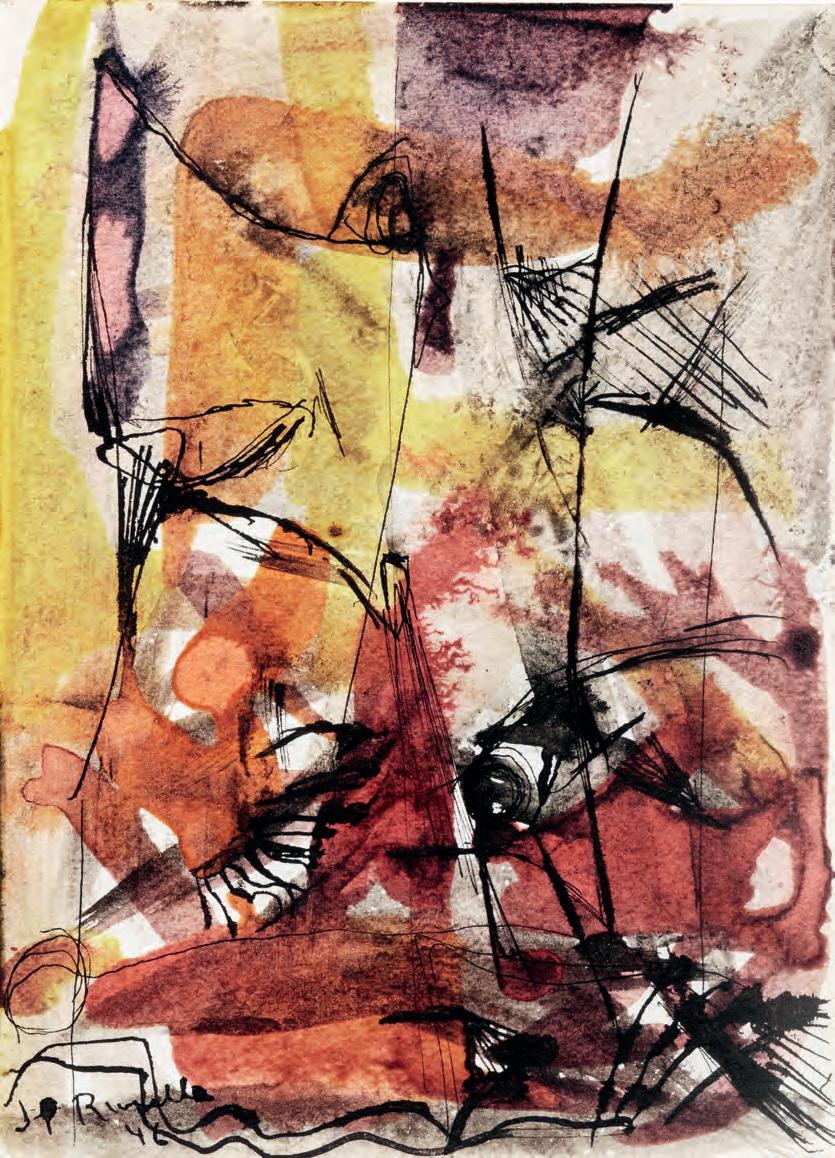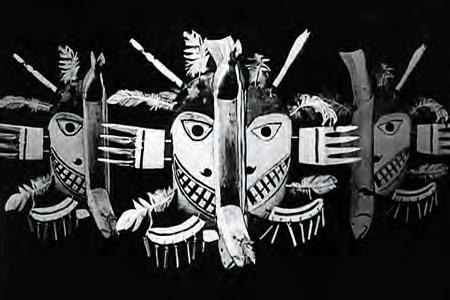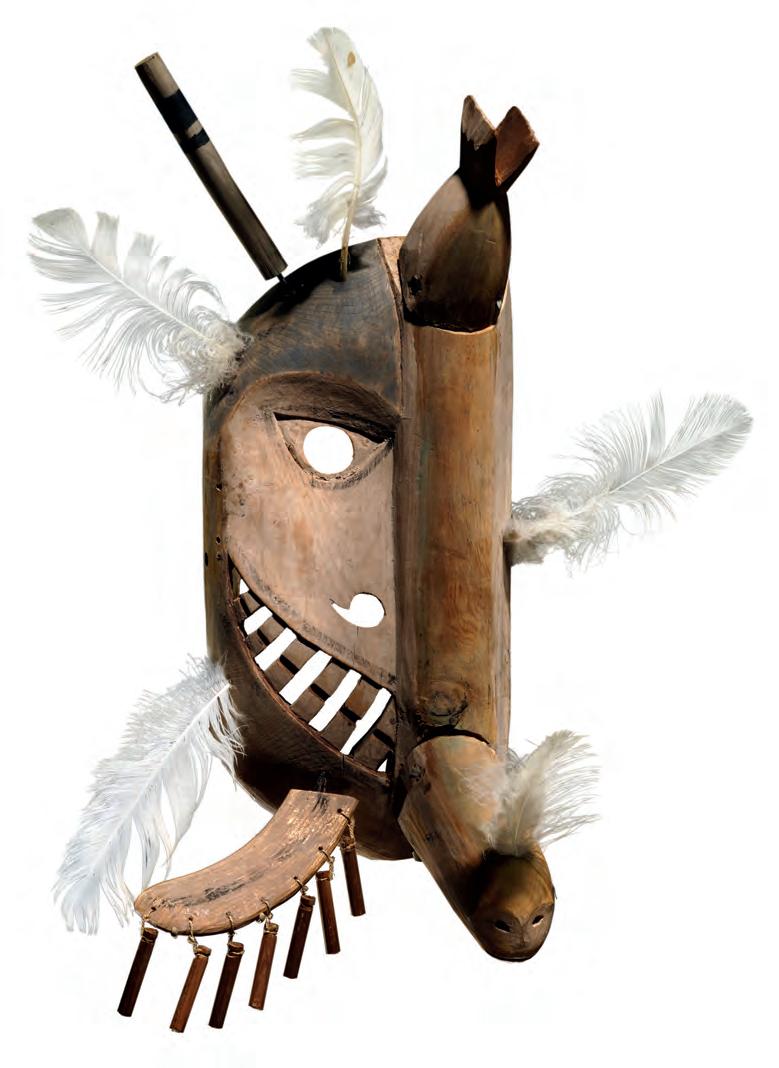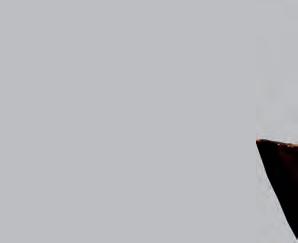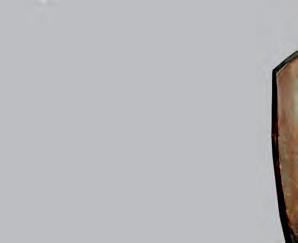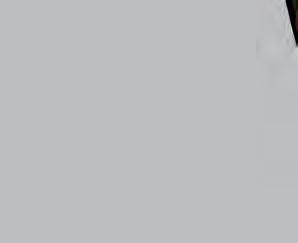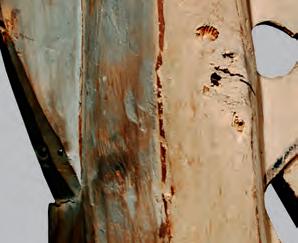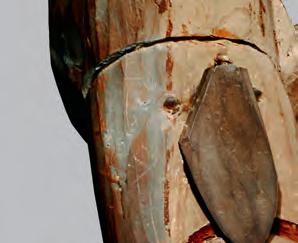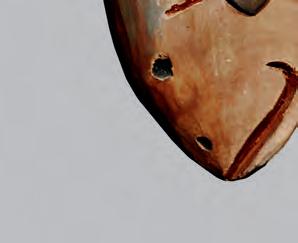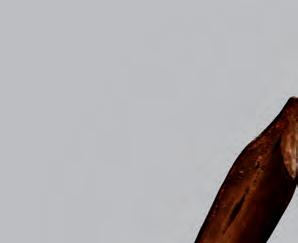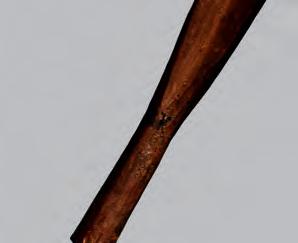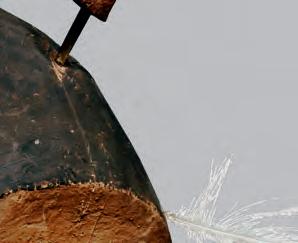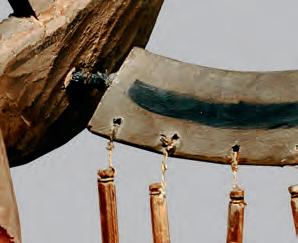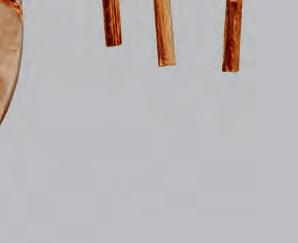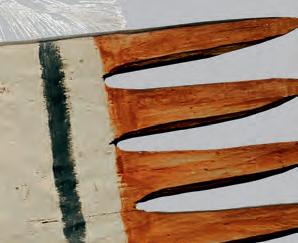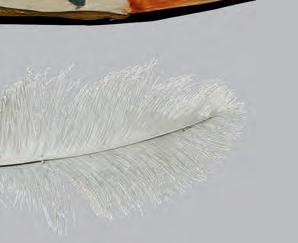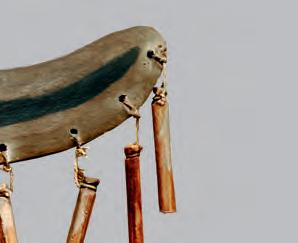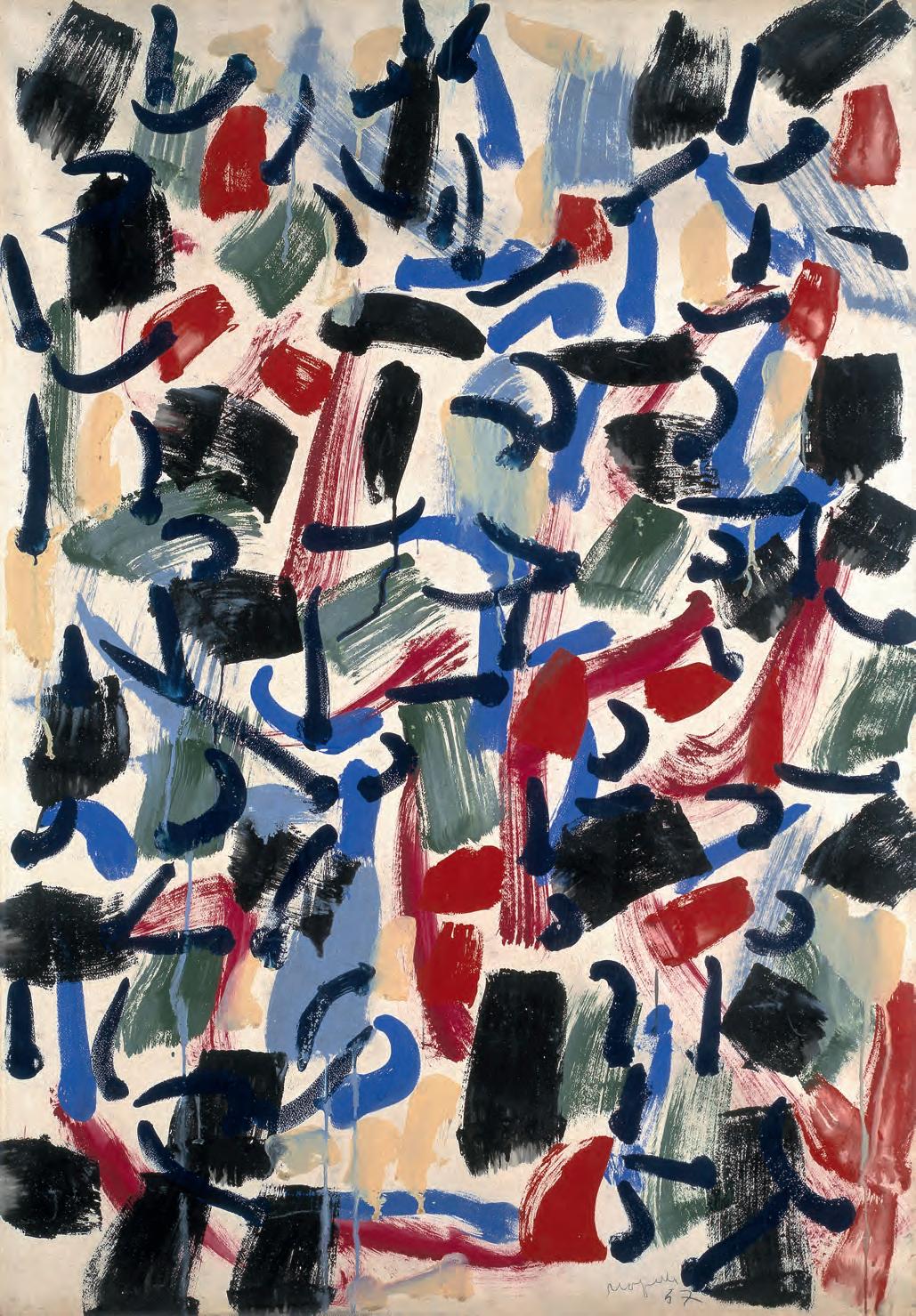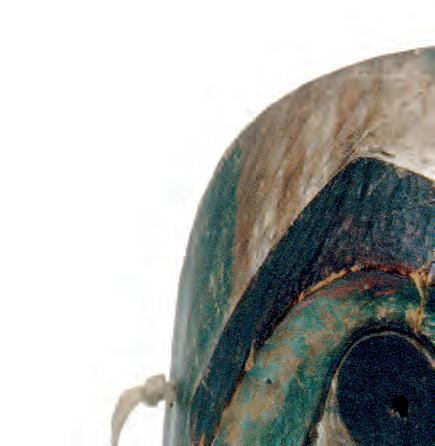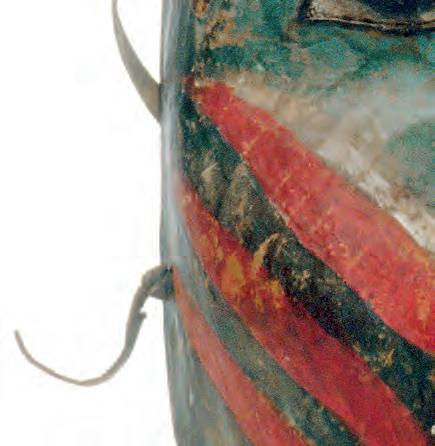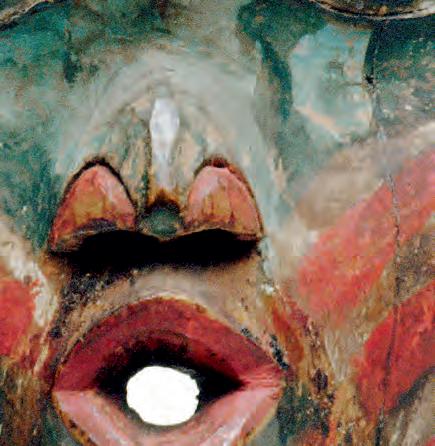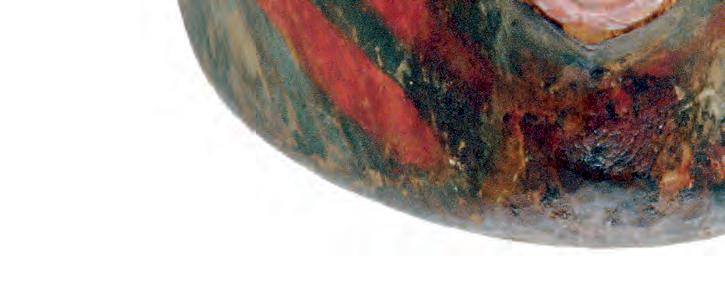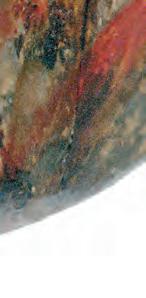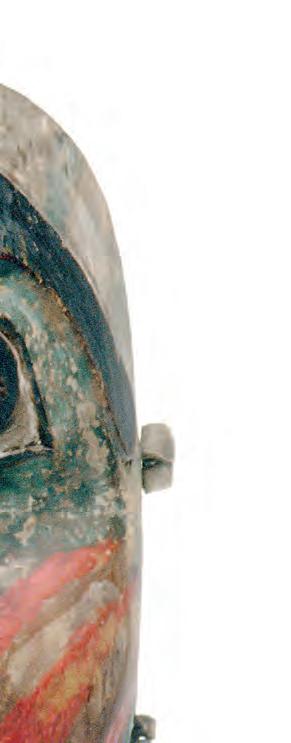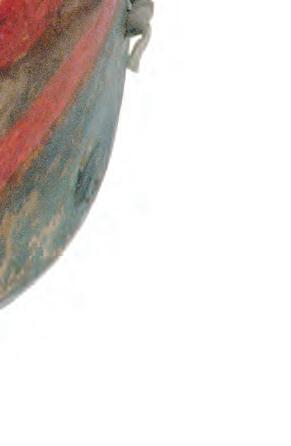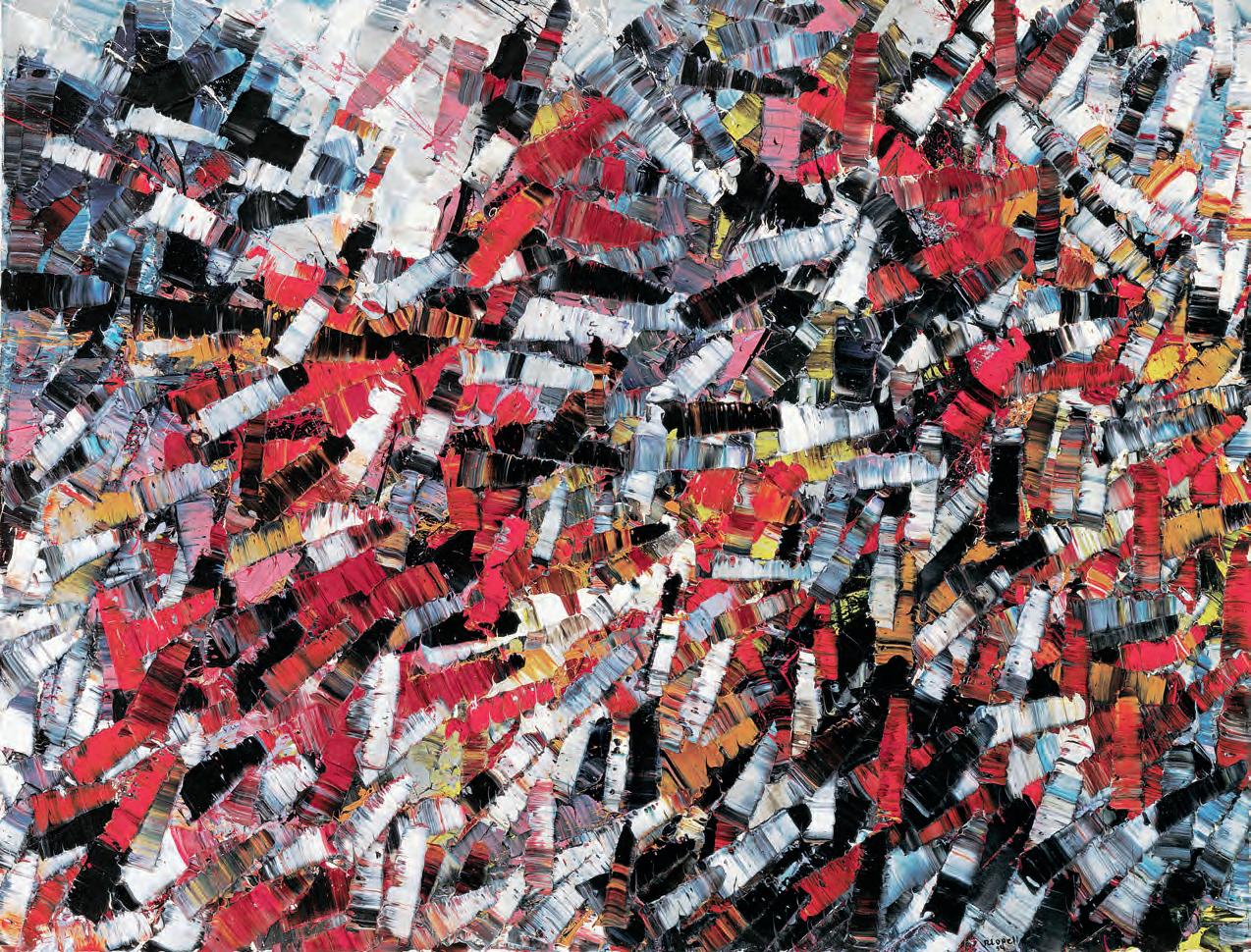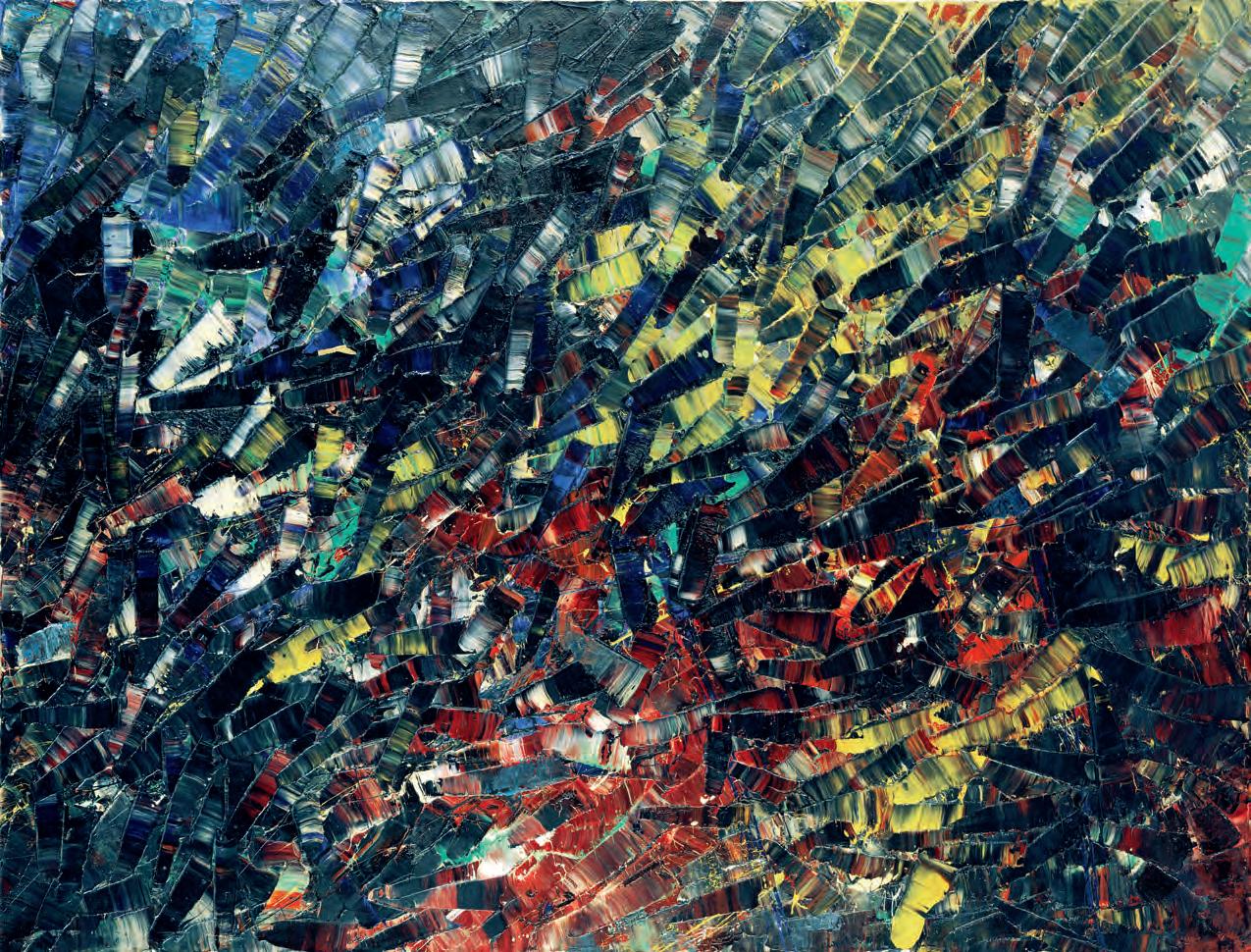In 1947, Riopelle met Pierre Loeb, who became his primary art dealer from 1952 to 1956. Loeb (shown here among ar sts of the Lyrical Abstrac on circle) introduced the ar st to Surrealists who collected non-Western art, in par cular North American Indigenous art, including André Breton, Robert Lebel and Isabelle Waldberg.
1 Denise Colomb Jean Paul Riopelle, Jacques Germain, Maria Elena Vieira da Silva, Pierre Loeb, Georges Mathieu and Zao Wou-ki 1953
2 Georges Duthuit in his University Street studio in Paris with Riopelle’s Un tled (1954) and Northwest Coast Indigenous objects in his collec on N.d.
In 1948, Riopelle became friends with Georges Duthuit, Henri Ma sse’s son-in-law. The art historian specializing in Byzan ne art and eri c of contemporary art was also a collector of North American Indigenous art.
Bouchard
200 Stacy A. Ernst and Ruth B. Phillips
Andréanne Roy
178
François-Marc Gagnon and Andréanne Roy
ICEBERGS:
268 CHRONOLOGY
Andréanne Roy, Bruce H. Russell, Louis Gagnon, in association with Ruth B. Phillips and Jacques Des Rochers
Séguin
274 SELECTED BIBLIOGRAPHY
278 LIST OF ILLUSTRATIONS
288 COPYRIGHT AND PHOTO CREDITS
1. Riopelle (Montreal: The Montreal Museum of Fine Arts / Connaissance des arts, 2002), p. 115.
2. The pan-Canadian exhibi on Riopelle: A Space of Freedom shown at the Centre d’exposi on de BaieSaint-Paul in 1998, consis ng of works from the studio inventory, prefigured the exhibi on at the Montreal Museum of Fine Arts. See Riopelle (Montreal: The Montreal Museum of Fine Arts / Connaissance des arts, 2002), p. 4.
3. Riopelle, 2002, back cover flap.
4. Eulogy given by Nathalie Bondil at the funeral of Bernard Lamarre, Mary Queen of the World Cathedral, April 15, 2016 (private archive).
5. Ibid.
6. Ibid.
7. Ibid.
8. Marie Pâris, “Lauren des : un resto dans le mythique bistro à Champlain,” Voir, June 13, 2019: h ps://voir.ca/ restos/2019/06/13/lauren des-unnouveau-resto-dans-lancien-bistroa-champlain/ (accessed July 15, 2020).
9. Champlain Charest to Nathalie Bondil, July 5, 2020.
10. According to Yseult Riopelle (July 5, 2020), Riopelle’s plan dates to 1968, after the opening of the Fonda on Maeght in 1964, but there are no documents of that me to this e ect.
11. The exhibi on Riopelle was held at the Montreal Museum of Fine Arts from November 26, 1991, to January 19, 1992.
12. Except for the magnificent pain ng Autriche III, acquired for the Montreal Museum of Fine Arts by Evan H. Turner in 1963.
13. Champlain Charest to Nathalie Bondil, July 5, 2020.
7 Éliane Exco er Paysage, Île-aux-Oies 2003
8 Marcel Masse, Riopelle, unknown, Clément Richard, and Bernard and Louise Lamarre at Château-Musée de Vallauris in France for the opening of the exhibi on Jean-Paul Riopelle : laves émaillées, terres, peintures 1985
I REMEMBER SOME LARGER-THAN-LIFE ENCOUNTERS ON THE TRAIL OF JEAN PAUL RIOPELLE
I REMEMBER JEAN PAUL RIOPELLE
It was cold and windy on the Saint Lawrence back in the fall of 2001. In my capacity as Chief Curator of the Montreal Museum of Fine Arts, I took a trip to the Isle-aux-Grues with my friends Stéphane Aquin, Curator of Contemporary Art, and his companion, the photographer Éliane Exco er. We had been invited to the Manoir MacPherson, at the p of the island, where Riopelle lived with his last companion, Hugue e Vachon: “It’s like being on a boat. I can hold out for a prolonged siege, spend the en re winter if necessary. An island is a sailing ship without a mast.”1 Hugue e welcomed us. Later, we visited the studio, Le repaire, a li le house suspended between the sky and the water that anchored Riopelle’s connec on with the land. The large, old-fashioned, pink cast-iron stove in the middle of the room was an amusing touch. A taxidermied goose frozen in flight hung from the ceiling. Through the windows, we could see the roiling river as it flowed seaward and, beyond the confines of the private hun ng grounds, the public road of Île-aux-Oies. There was no smell of paint or turpen ne—Riopelle no longer painted. The studio was a mausoleum. The ar st had moved on. Éliane photographed the evening by candlelight—the state of the premises, the state of the god. It was all somewhat melancholy. We had come because we were planning a Riopelle exhibi on at the Museum for June 19 to September 29, 2002.2 We slept at the Manoir, where I was struck by the vitality of a paint-spa ered wooden easel. We decided to borrow it. As it turned out, the exhibi on was posthumous: Riopelle died not long after our visit, on March 12, 2002. He was given a state funeral. The easel, a symbolic absence, a monumental presence, was planted in an exhibi on gallery like a cross: “Now my country is pain ng.”3
I REMEMBER BERNARD LAMARRE
Art was not simply a diversion for this excep onal entrepreneur but, as he told me, “a source of inspira on for my life project, my professional project... It is ar sts I have taken as my model, it is they who inspired me... Mee ng people with the ability to create s mulates me, encourages me to do the same in engineering and pushes me to try original things.”4 He considered his ar st friends— Daudelin, Mousseau, Soulages, Riopelle—not “beneficiaries, but partners.”5 Impressed by Refus global, Bernard wanted, goodnaturedly, to “thaw out our fellow ci zens, make them enterprising, able to compete on the interna onal scene, ins ll them with self-confidence and the desire to experiment.”6 His strength of entrepreneurial convic on always remained at the core of his strategy as a builder: “I owe my appe te for risk in part to ar sts.”7 He did not need to hope in order to undertake or to succeed in order to persevere. He was a pioneer, a giant in the vision of a modern Quebec and Montreal as a “cultural metropolis.”
A jolly threesome saw each other often in Estérel; the Lamarre family’s country retreat was in nearby Sainte-Adèle. They would gather for a fine meal at L’Eau à la bouche or at the restaurant Riopelle had christened Le Va-nu-pieds, in Sainte-Marguerite-duLac-Masson, near his studio. In 1974, the ar st had alerted his
friend Champlain Charest to the fact that the general store was for sale. Property developers wanted to demolish it and build a motel: “You have to buy it! This building cannot be demolished, it is too important to the village.”8 Famous for its wine cellar, a must for wine-lovers from here and abroad, the restaurant was later known as the Bistro à Champlain. Champlain recalls a wi y remark made in the 1990s by Bernard—who was never at a loss for a pun—at a memorable feast in the studio, during which Riopelle was ruing the dearth of patrons in Quebec. “I’m no patron (mécène),” Mr. Lamarre said. “I watch my pennies (me cennes).”9 In fact, he did a lot for the ar st. With his friend Clément Richard, Quebec Minister of Cultural A airs under René Lévesque, he supported the idea of a Jean Paul Riopelle Founda on, for which there were several a empts on paper as early as 1980.10 In 1985, Bernard and Clément accompanied Riopelle to the Riviera for the opening of his exhibi on of enamelled lava works at the Château-Musée de Vallauris. A major Riopelle retrospec ve11 inaugurated the Jean-Noël Desmarais Pavilion of the Montreal Museum of Fine Arts, whose president at the me was Bernard Lamarre, the ini ator of the largest cultural building project in Quebec. Although the ar st was famous interna onally for his lyrical abstrac on, he was, alas, poorly represented in Quebec museums at the start of the twenty-first century.12 For this reason, in 2001, Bernard Lamarre, s ll president of the Montreal Museum, convinced the Quebec government to grant it and the Musée na onal des beaux-arts du Québec funds for acquiring two large bodies of work from the ar st’s estate.
I REMEMBER CHAMPLAIN CHAREST
If ever there was a symbolic name, it is this instance of Champlain, evoking the figure behind the “grand design” for New France. The child was given the name by his grandmother in honour of the parish chaplain,13 but to me it represents a kinship with the spirit of adventure. I met Champlain through the ar st Marc Séguin and the chef Mar n Picard, his hun ng companions and gargantuan dinner companions. However, it is with Bernard Lamarre that, as a young museum director, I visited Champlain’s collec on—the Riopelles in par cular—at Habitat 67 and, during an aesthe c and gastronomic ou ng, at his Sainte-Marguerite bistro. The two men enjoyed each other’s company, and their easy conversa on was a delight to their listener. In 2016, I informed Champlain that Bernard wished to say his farewell. It was an intense moment. Bernard died as he had lived, a winner. It is at such intense moments that the most binding promises are made, and I promised to organize an exhibi on with Champlain. I set out on this project with Bernard’s eldest son, Jean, an excellent man who died tragically in 2017. At the Museum’s restaurant and at Champlain’s bistro, presided over by the cri cal acumen of his taste buds, we listened to extraordinary accounts of the special friendship between Riopelle and his friend and patron. After the two men met in 1968, they hunted and fished together, which brought Riopelle back to this country more often. In 1974, their friendship grew stronger when the ar st built a studio on
Nathalie Bondil
11 | Point de rencontre – Quinte e is the largest pain ng Riopelle ever made and the only one completed for an o cial commission. Executed in Paris for the Toronto Pearson Airport, it was given to France by the Canadian government to commemorate the bicentennial of the French Revolu on. It was on display at the Opéra Bas lle in Paris from 1989 to 2018. Its technique and composi on are characteris c of the ar st’s produc on from the early 1960s, in which more clearly defined mo fs stand out against a homogenous background. The tle refers to Toronto and the history of the area’s Indigenous occupants. The Huron word toronto can be translated as “place of mee ng” (point de rencontre in French), poin ng to the geographical importance of this crossroads by way of which Indigenous peoples made their way between Lakes Ontario and Huron. – AR
11 Jean Paul Riopelle Point de rencontre –Quinte e (polyptych) 1963 Oil on canvas
then that, having learned of plans for a major exhibi on that Yseult Riopelle held dear and had been direc ng her research towards since 2003, we joined forces to come up with an exhibi on of wider scope capable of shedding new light on the ar st’s approach. Following the 1991 and 2006 retrospec ves of Jean Paul Riopelle’s work held at the Montreal Museum of Fine Arts, the exhibi on Riopelle: The Call of Northern Landscapes and Indigenous Cultures features a fresh look at two of the guiding themes that punctuated the output of one of Canada’s greatest ar sts.
Looking into the sources of inspira on that could have sparked the ar st’s imagina on with regards to our two themes, our discoveries revealed not only a nature-loving man—a well-known side of him—but also a cultured man who drew inspira on from the books he would devour and the exhibi ons he took in, notably of First Na ons and Inuit art. Besides enjoying the occasional company of Indigenous hun ng and fishing guides, it was above all through books and exhibi ons that Riopelle fuelled his interest in Indigenous communi es and their lands and material culture. This intellectual and ar s c pursuit had a par cularly decisive impact on the ar st in the 1950s and 1970s.
Also brought to light is the uncontestable sway of certain collectors from within the Surrealist milieu, especially the writer André Breton and the art historian Georges Duthuit. Not only was Riopelle able to become acquainted with their collec ons of non-Western objects, but he also maintained with them rela onships that excited his interest in dis nct cultures, especially those of North America. Many of the tles he gave to his abstract works speak to this. Yseult Riopelle’s archival research has uncovered, among other things, new details regarding the intellectual connec on between Riopelle and Georges Duthuit. They planned to co-publish a book inspired by the arts of the Pacific Northwest Coast, in collabora on with Marius Barbeau: Riopelle, who had met the Canadian anthropologist, was to have done the illustra ons! We unearthed correspondence with the la er’s son-in-law, the sociologist Marcel Rioux, that further tes fies to this.
Furthermore, our research into the 1970s period has deepened what is known about the areas Riopelle visited in the North and produced a be er sense of the fascina on he had with them. A decade full of northern subjects— consider Jeux de ficelles (1971–72), Rois de Thulé (1973) and Icebergs (1977)—this period saw Riopelle take marked inspira on from Inuit culture and the northern landscapes. He was also influenced by the toponymy of the Indigenous peoples of Eastern Canada. As well, his a en on con nued to be turned towards the Pacific Northwest Coast during this decade, as seen especially in a series of silverpoint drawings incorpora ng the rich iconography inspired by several pieces in Duthuit’s collec on and borrowed from certain anthropological publica ons. We lift the veil on this li le-known corpus by showing the sources that inspired them.
16 | As an ac ve par cipant in the winter ceremonial life of his Kwakwaka’wakw community, contemporary carver Beau Dick brought to his work not only an ini ate’s understanding of the secret socie es of his people, but also a wide knowledge of other coastal, as well as interna onal and transhistorical, ar s c tradi ons. Great ar sts are acutely aware of what they see, both within and outside their own cultures, and this is as true of Indigenous contemporary ar sts as it is of any others. Friends and cri cs, as well as Dick himself, have suggested influences as diverse as Japanese manga, the Italian baroque and neighbouring coastal tradi ons. From the perspec ve of his own mask-oriented material culture, Dick was a racted to the masks of the Alaskan Yup’ik. Closely based on a well-known prototype, Dick’s “copy” introduces subtle touches to this work carved in his last years, like the carved hands that echo those used in his own culture’s dances. – BHR
16
16 Beau Dick Weather Spirit N.d. Wood, leather, twigs, paint
IN PARIS US ARTS FR ANCE”: FROM MYESKIMOS AND T HE
Copy of a design for a tarot card (verso of 46) About 1946 Ink on paper
45 Kay Sage Design for a tarot card 1941 Gouache, brush, pen and India ink on paper
46 Jean Paul Riopelle Un tled (recto of 44) 1946 Watercolour and ink on paper
Riopelle discovered Yup’ik art through his connec ons with the Surrealists. On the back of this watercolour that once belonged to André Breton is a drawing by the American ar st Kay Sage, which was largely inspired by the Fish Mask in Breton’s collec on. Two di erent ar s c expressions and tradi ons that enable the “re-enchantment of the world” are blended together here, marking the link between them: the explora on of automa sm in pain ng, and the vision quest in Indigenous produc on. The la er was a tremendous source of inspira on for the Surrealists, including Sage.
43 Jean Paul Riopelle Un tled 1947 Watercolour and ink on paper 44 Kay Sage
48-49 | Historically, the crea on of a tradi onal Yup’ik dance mask began with the vision of the village angalkuq, the shaman who would either create the mask directly, or would commission its crea on from skilled carvers. The vision of the angalkuq would be manifested in a song, forming the basis of the dance narra ve to be performed. The design of a mask was often a complex compila on of the various verses and ac vi es being described in the dance. Usually, Yup’ik masks were created in pairs or groups, each mask reflec ng the par culari es of the verses and dance structure. There are many terms in the Yup’ik language to describe the mul plicity of forms these paired masks can take.
Yup’ik dance masks follow centuries of tradi onal vocabularies, and numerous symbols immediately understood by the audience are included. Items such as the ellanguaq (pretend universe or consciousness) are found in the form of a hoop or ring, made from bent spruce roots and adorned with feathers, surrounding the top crown of the mask. The ellanguaq represents the threshold between planes of consciousness, through which the spirits (and the angalkuq) must pass.
Perhaps the most important and central feature of the mask is the yua (personal spirit), which is often represented as a human face emerging from the centre of the mask’s animal body. In the Yup’ik cosmological system, all beings are expected to possess a yua, and every object (visible and invisible) has the poten al to be alive and have a spiritual essence. For this reason, among many others, great respect is paid to every living creature, upon which life in the Arc c depends for survival. – SM
48
47 Film s ll from L’inven on du monde : les surréalistes et le cinéma (1952)
Southwest Alaska, Yup’ik Mask About 1910 Driftwood, baleen, feathers, paint, co on twine
49 Southern shores of Kuskokwim Bay, Goodnews Bay, Yup’ik Mask represen ng a fish Early 20th c. Painted wood, feathers
66 Jean Paul Riopelle Un autre Gitksan 1957 Gouache on paper
67 Bri sh Columbia, uniden fied origin
Human-face mask with clan crest markings
About 1800–50 Painted wood
86 Jean Paul Riopelle Blizzard 1954 Oil on canvas
87 Jean Paul Riopelle Blizzard 1954 Oil on canvas
COPYRIGHT
All rights reserved for documents whose provenance is not identified. In the event of error or omission, the publisher asks copyright holders to get in contact.
All works by Jean Paul Riopelle: © Estate of Jean Paul Riopelle / SOCAN 2020
Courtesy Estate of Fred Bruemmer
© Estate of Beau Dick
Noah Arpatuq Echalook and Mattiusi Iyaituk: Fédération des coopératives du Nouveau-Québec
© Éliane Excoffier
© Bruno Massenet
© Succession H. Matisse / SOCAN (2020)
Pudlo Pudlat © Reproduced with the permission of Dorset Fine Arts
© Estate of Kay Sage / SOCAN (2020)
Archives catalogue raisonné Jean Paul Riopelle: 3, 5, 6, 19, 20, 56, 57, 60, 62, 63, 64, 65, 66, 74, 76, 77, 80, 84, 86, 87, 90, 91, 97, 103, 105, 107, 108, 109, 120, 121, 123, 124, 126, 137, 138, 143, 145, 146, 147, 148, 149, 150, 151, 152, 155, 156, 157, 160, 176, 181, 184, 185, 189, 197, 199, 202, 203, 206, 207, 211, 216, 217, 218, 219, 221, 223, 224, 246, 247, 248, 263, 267, 269
Archives catalogue raisonné Jean Paul Riopelle. Photo Vancouver Art Gallery, Trevor Mills: 61
Archives Yseult Riopelle: 8, 17, 21, 23, 24, 79, 100, 101, 153, 154, 170, 187, 188, 245, 250, 251, 252, 253
Photo Denise Colomb – Archives Yseult Riopelle: 1
Photo Dominique Darbois – Archives Yseult Riopelle: 205, 208, 225
Photo Claude Duthuit – Archives Yseult Riopelle: 10, 14, 161, 162
Photo Jacqueline Hyde – Archives Yseult Riopelle: 175
Photo probably by Jean Lespérance – Archives Yseult Riopelle: 81
Photo Rosie Rey – Archives Yseult Riopelle: 195, 196, 198, 204, 209, 210, 222, 226
Photo Sylvie Riopelle – Archives Yseult Riopelle: 82
Image courtesy Albright-Knox Art Gallery: 59
© Alianait Entertainment Group: 112
Applicat-Prazan, Paris: 43
Archive Photos / Getty Images: 53
Bibliothèque Kandinsky – MNAM –CCI – Centre Pompidou, Paris: 2, 18, 27, 29, 30, 31
Alison Bremner: 193
Brooklyn Museum: 58
Canadian Museum of History: 28, 33, 35, 117
Choses Vues, Paris / Rights reserved: 47
CNAP: 11
F.C.N.Q.: 134
© Photo Galerie Maeght, Paris: 111, 125, 136, 140, 180
Richard P. Goodbody, Inc. New York: 44
Anita Henry: 159
Heritage Image Partnership Ltd / Alamy Stock Photos: 131
Institut culturel Avataq. Photo Robert Fréchette: 132
François Lafrance: 262
Guy L’Heureux: 75
© Library and Archives Canada. Reproduced with the permission of Library and Archives Canada / e011435420: 114
© Library and Archives Canada. Reproduced with the permission of Library and Archives Canada/Basil Zarov fonds/e011205146: 15, 83, 93, 94, 172, 173, 174
Lianed Marcoleta, courtesy of the Winnipeg Art Gallery: 115
© McCord Museum: 68
The Montreal Museum of Fine Arts: 71, 110; Jean-François Brière: 102, 171; Denis Farley: 4, 85, 98, 139, 144, 177, 179, 183; Christine Guest: 12, 67, 69, 70, 88, 104, 106, 119, 178, 186, 220, 227, 229, 230, 231, 232, 233, 235, 236, 237, 239, 241, 242; Brian Merrett: 265, 266
Musée d’art contemporain de Montréal: 268
Digital Image © The Museum of Modern Art / Licensed by SCALA / Art Resource, New York: 78
Musée national des beaux-arts du Québec, Idra Labrie: 13, 163; Denis Legendre: 73, 135
© Musée du quai Branly-Jacques Chirac / Dist. RMN-Grand Palais / Art Resource, New York: 34, 49, 55
Produced and distributed by the National Film Board of Canada: 191, 256, 258
Photo National Gallery of Canada: 116
NMAI Services: 48
Kent Pell: 122, 158, 182
Philadelphia Museum of Art: The Louise and Walter Arensberg Collection, 1950: 240
Image courtesy of the Royal BC Museum and Archives: 201
c/o Kay Sage Catalogue Raisonné, New York: 45
Pamela Saunders: 200, 270
Roger Smith: 264
Courtesy of University of British Columbia Museum of Anthropology. Photo Kyla Bailey: 212, 213, 214, 243, 244
Cover: 177
